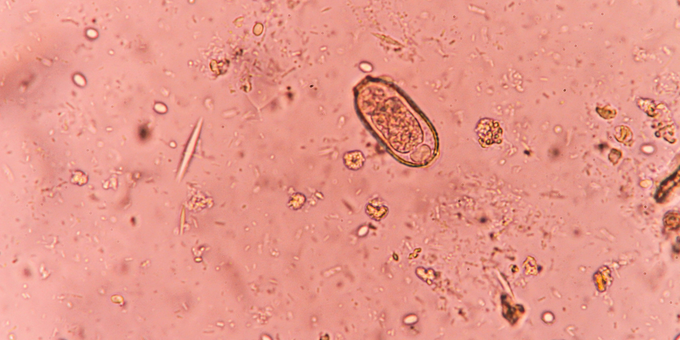With nearly a third of us sharing our bodies with parasites, these infections are a lot more common than we’d like to think. Here are the signs to look out for, plus we take a dive into what parasites actually are and how they wind up taking up residence in your gut.
Parasites are organisms that live in a host species – in other words... us! They then proceed to feed off of the host by sapping nutrients from them, resulting in a number of uncomfortable symptoms. These parasite infections can range from intestinal worms and giardiasis down to your garden variety mosquito – but we’ll be focusing on the kinds of parasites that live in your gut, and how to know they’re there.
Parasitic infections can be spread in a number of ways, depending on the type of organism. Protozea – which is type of organism responsible for the giardiasis parasitic infection – is often spread via water and food sources that have been contaminated, along with soil and bodily fluids like blood. Hemlinths – what we know as worms – are organisms that can live both in and out of the body, but they’re most well known for their tendency to invite themselves into your gut. These worms include tapeworms, thorny-headed worms, flatworms and roundworms – these cause the highly common threadworm infection which is estimated to affect anywhere between 10 and 50% of Aussie kids.

These types of parasites are commonly spread in much of the same ways as protozoan infections, by contact with contaminated foods or environments. Take a look at some of the intestinal worms that are known for wreaking havoc on the gut:
Tapeworms
The most common way to get a tapeworm infection is through food or water that has been contaminated by this parasite or its eggs – in fact, ingesting the eggs can result in them hatching inside your body and moving out of the intestines and into other bodily tissues and organs, potentially causing larval cysts. Yikes. Maybe give that food you dropped on the floor a miss – the 3 second rule is sadly nothing but a myth! Another common cause of this infection is through raw beef or pork – this is because these are often infected by these parasites. Here’s the part that might make your skin crawl – these guys can grow as long as 25 metres in your intestines. Yes, you read that right.
Threadworms

Threadworms, also known as pinworms, are one of the most common types of parasitic infections, both in Australia and around the globe. There’s an estimated 1 billion people living with these parasites, and while children are the most common hosts, adult infections aren’t uncommon as these infections are easily spread when living in close contact with others. This could be through exposure to faecal matter from poor hygiene – this may happen in the bathroom or even in the kitchen when preparing food, so take this as a reminder to always wash your hands when you’re getting creative in the kitchen and when eating!
Hookworms
These worms are living in nearly 750 million people around the world. Luckily, these parasites are relatively rare in Australia, but some people may become infected through their dogs as our canine friends are much more likely to pick up these unwanted house guests.
If you’ve been living with a number of the following uncomfortable symptoms for a while, it could be a parasite. Here are some of the major signs that accompany an infection:
- Fatigue
- Brain fog
- Bloating and constipation
- Diarrhoea
- Stomach pain
- Muscle or joint pain
- Sleeping difficulties
- Irritable moods and mood changes - the toxins these parasites release can even cause anxiety!
- Itchiness around the anus
- Rashes and skin irritation
- Weight loss with no known explanation
- Visible worms in your stool
While it’s best to follow your doctor’s advice if you’re dealing with a parasitic infection, there are a number of foods you can add to your diet that are known for their antibacterial, antiviral and anti-parasitic properties – take a look at some of the research-backed options:
- Garlic – raw is best
- Pumpkin seeds
- Pomegranates
- Carrots
- Papaya seeds

But remember some infections cannot be treated without medical assistance, and as such it may be best to get a doctor’s diagnosis to be certain of what you’re dealing with, along with getting their advice for a a treatment plan.
Keen for more health tips and tricks? We’re here to help. Join us for the 8-Week Program where we’ll be quitting sugar and turning our health dreams into a reality. When you sign up with us, you’ll have access to clear-cut meal plans, community support and exclusive access to our sugar-free content. Here’s what’s on offer:
- 8 weeks of meal plans and shopping lists.
- 90+ member-only recipes.
- Community forums to share your journey.
- Support and guidance from the I Quit Sugar team.
- Exclusive content from our panel of experts.
So, if you’re ready to ditch sugar and the host of maladies that come with it, it’s not too late to JOIN NOW!






Leave a comment (all fields required)